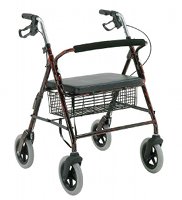Selection and Assembly of a Rollator
https://www.youtube.com/watch?v=_lMv7hzXmVY
Selection & Assembly of Rollator Walkers
(Also called: 4 Wheel or 4WW)


Rollators (also called 4 wheel walkers) are just that – walkers for elderly with four wheels, brakes, a seat and a basket/bag. They work well both indoors and outdoors – especially models with large wheels that easily roll over uneven ground and carpet. Selection & Assembly of a Rollator
Who Should Use a Rollator?
Elderly who need a walker for balance but do not need to put much weight onto it. It is also beneficial for seniors who need a seat to rest, want to carry items and want the security of having something to hold onto when walking. Most versions are also foldable and can fit in the trunk of a car. The styles with larger wheels are recommended as they roll easier on uneven ground and are usually more stable.
Who Should NOT Use A Rollator?
Elderly who have a sore foot/leg/hip and the doctor does not want them to place weight onto it (ex. post hip surgery). This is usually temporary and the senior can progress to a rollator at a later date.
Elderly with significant balance, strength and endurance issues. They may be safer using a two wheel walker or wheelchair – depending on what is causing their difficulty walking.
How to Use a Rollator
- Adjust to proper height – see below for how to fit a walker
- Lock brakes – I recommend locking the brakes anytime elderly are sitting down on the walker’s seat or getting up/down from a chair/bed/couch with the walker in front of them. On most rollator walkers with seats, the senior can lock the brakes by pressing the brake levers down till they lock in place. This ensures the walker will not roll away from the user.
- Get in position – Place both hands on the handles.
- Stand upright – This will likely place the users toes/midfoot in line with the rear wheels
- Walk normally – Try to stay in a normal upright walking position and not to hunch over or get the walker to far ahead.
- Small steps – Take small steps especially while turning around – for example to turn around to get into a chair.
- Using seat – Find level ground, lock brakes, turn around and sit down. Do not sit down to hard as brakes are built for light hold only.
Recommended Features
- Large wheels – Larger wheels roll over uneven ground easier which makes it more enjoyable to use outside and also safer.
- Lightweight – Some walkers are too heavy for smaller seniors as they cannot push them around easily – putting them at risk of falling.
- Easy to use brakes – Some brakes are too stiff for elderly so be sure to have the senior try the brakes – both squeezing them as well as locking them.
- Padded seat – Elderly will use the seat if it is comfortable.
- Basket/Bag – I prefer models that allow easy access to the basket/bag while in the normal walking position. Baskets that are only accessible by reaching over top or around the walker are not safe and inconvenient.
Accessories
- Standard options – Most walkers come with several standard features such as a basket/bag and padded seat.
- Oxygen tank holders – Some walkers have enough room in the basket/bag for an oxygen tank or small portable concentrator. Others will benefit from an oxygen tank holder. Make sure it keeps the weight low to the ground or it makes the walker top heavy and prone to tipping over – Especially on uneven ground outside (such as a curb cutout at a crosswalk).
- Cane holder – To hold their cane securely.
How Much Does a Rollator Walker Cost?
Rollator walkers for elderly (four wheel walkers) will cost $100-600+ depending on the quality and features.
Source: Medline


